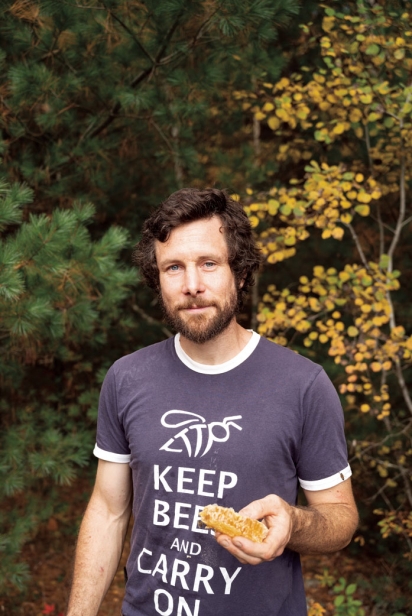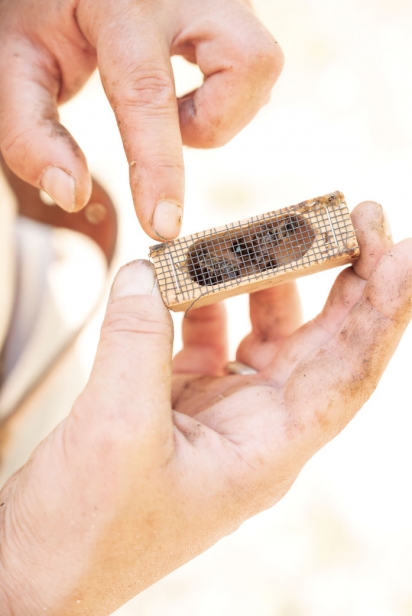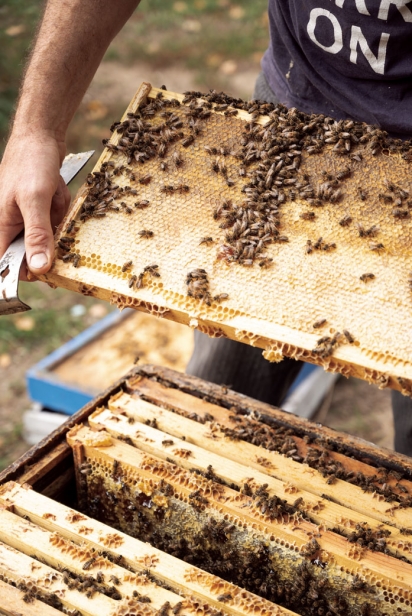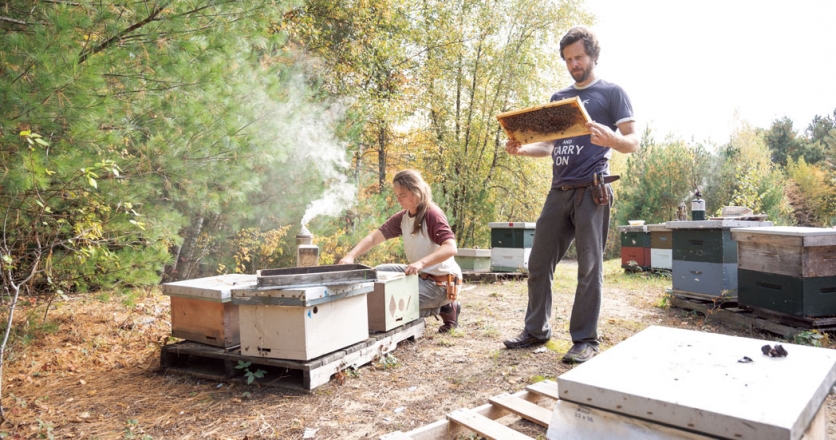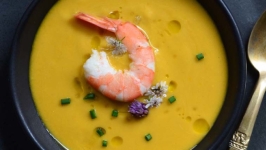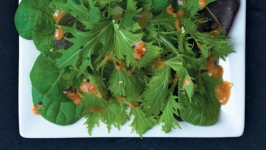For the Love of Bees
Brian Lacey is a honey producer, queen bee breeder, meadmaker and all-around bee nut who has worked with bees since his first year at university. You could say he really loves bees.
While you and I see a flying insect that’s important in our ecosystem for pollinating our crops and making honey, Lacey sees individuals with special characteristics. On a recent visit to one of his bee yards — a sheltered circle surrounded by tall pine trees where there are about 35 hives — he points out one of them fondly. “The queen bee in here is five years old,” he says, with a touch of pride. “She’s a great producer.”
On average, a queen bee lives and lays eggs for three years. These days though, with so many stressors on bees, such as insect infestations and mites, colony collapse disorders, pesticides, fungicides and other pollutants, many beekeepers struggle with colonies that die from one year to the next. So, a long-lived queen is a precious commodity, one whose genes are worth propagating.
That brings us to Ontario mutts. Lacey breeds queen bees to sell in the late spring and early summer to beekeepers, both amateur and professional, whose colonies are without one. A colony without a queen dies off quickly as no baby bees are being hatched to replace those who die by the hundreds daily. It’s time consuming and tricky work as it requires a delicate touch, deft hand and excellent eyesight.
Since he turned 40, Lacey jokes that his eyesight isn’t up to the job any longer, so his colleague Charlotte Doyle has mostly taken over the queen-bee propagation. Doyle, although new to beekeeping in the spring of 2019, “is really, really good at this,” Lacey says. “She has a very high success rate.”
“Queen rearing is what I like doing best,” says Doyle, while showing a grafting tool, an instrument that looks like a miniature spoon. “I’m interested in the technical side of grafting larvae. It’s quiet, I’m alone and I really enjoy it.” Very carefully, she scoops a recently hatched larva out of its cell and puts it into a queen cell where other worker bees will feed it royal jelly, so it develops into a queen bee. “You mustn’t drop it or change its position, or it won’t survive,” she explains. “I like seeing which ones make it, and now I have a relationship with some of the ones that do. I know I had a part in their life.”
As COVID-19 shut down the world, panic ensued in the beekeeping community. Many commercial beekeepers rely on imported queen bees flown in from warmer climates such as Australia, California, Hawaii and Chile in early spring. But in 2020, there were none. “There was a huge local demand,” recalls Lacey, “but we can’t start rearing queens until later in the season in this climate, because it’s too cold.”
However, there are increasing local efforts to over-winter queens in the region and Lacey is among the beekeepers trying to breed hardy bees. His Ontario mutts are descended from original Russian bee stock purchased from Kelly Rogers, a respected breeder near Owen Sound. These Russian queens become Lacey’s mutts once they leave the hive to mate, “because we don’t have an isolated mating yard,” he explains, “so who knows what other bees the queen might have come into contact with.” However, he does something called drone-flooding, which increases the percentage of gene-selected drones in the area. This practice increases the likelihood that the queens will mate with desirable drones and produce strong colonies that will survive eastern Ontario winters.
Come spring 2021, Lacey hopes to be able to sell upwards of 600 queen bees to a wholesaler and local beekeepers, and also more than 50 nucs, which are queens with two frames of brood (unhatched eggs), one frame of feed, one frame of drawn comb, waiting to be filled with honey and two pounds of worker bees. This is the starting point for a new colony.
Lacey, who moved to the Ottawa area in 2015, bringing 80 hives with him from Guelph, now keeps 180 colonies all over the region. While studying ecology at the University of Guelph, he worked in the bee laboratory and the botany laboratory and graduated from the technology transfer program. The TTP, administered by the Ontario Beekeepers’ Association, takes in information from researchers and regulators to make it available to the average beekeeper. Since then, he has worked as a provincial bee inspector while keeping his own hives.
Lacey sells his honey under the Blue Shoes label, at the Westboro, Lansdowne and ByWard markets in Ottawa and through several retailers in the region. “I wanted a name that was catchy and wasn’t related directly to honey or bees. And I think rhymes are inherently attractive to people,” Lacey says. And while Blue Shoes might be a catchy name, it was also inspired by his little nephew who had a pair of electric blue shoes that he loved so much he would wear them to bed. Lacey loved them too.
He’s also about to take the plunge into the world of mead, with business partner Jean-Paul Simbandumwe. “There’s a new meadery opening every three days in the U.S.,” says Lacey, who keeps a further 100 hives separate from the honey hives, for this purpose.
Mead is honey wine. It can range from a dry wine to a very sweet dessert-style wine, or even beer and cider-like. Mead-makers, can flavour mead with apples, berries or herbs, spices, grains or hops. Mead is its own distinct thing about to explode in popularity, much like craft beers have done over the past five years.
Simbandumwe, who has a profound interest in food and wine and works in technology, has been developing his mead recipe for several years. The pair will start production shortly, under the label Mer Bleue Meadery. They’ll be selling at farmers’ markets and also through their newly renovated honey house and meadery in a converted horse barn, which is just to the east of Ottawa, alongside Mer Bleue at 5855 Russell Rd.
“I’d been passionate about beekeeping as an amateur beekeeper and wanted to produce single-varietal, small-batch honey,” Simbandumwe says, “but I quickly realized that it would be a niche interest, labour intensive and hard to do.” So, he turned his attention to the craft creation of mead. When he began getting very positive reviews from friends, he decided to take it seriously.
“The style of mead we will be producing at the start will be fruitforward, honey-forward and semi-sweet. It will be a little dryer than a late-harvest wine, with a careful balance of acids and sugar.” To date, the pair has four flavour profiles made with local fruit that include a cyser, which is a mead made with apples, one made with haskaps, another with sea buckthorn, goldenrod honey and Madagascar vanilla and yet another with dark berries, which is the deep red of a pinot noir.
It turns out that blue is the colour and honey is the glue that sticks the Blue Shoes and Mer Bleue team together. Lacey’s assistant, Doyle, met Simbandumwe while both were doing an evening beekeeping class. She met Lacey while working at the KIN Vineyards stand at the Westboro farmers’ market, adjacent to Blue Shoes’ stand. Now she will bring her love of bees to the mead colonies and her palate to the endeavour.
Lacey offers an annual two-day beekeeping course in May each year. Until recently, he did this with Brent Halsall, a provincial bee inspector and beekeeper with more than 30 years of experience. Halsall passed away during the summer of 2020. “He was the most generous mentor one could have,” Lacey recalls. “Brent would share his knowledge gladly and his equipment too. He never asked for anything in return. ‘Just pay it forward,’ he’d say.” As for the beekeeping course, “Our goal was to provide enough knowledge of bees and their management to keep a hive alive,” Lacey says.
If COVID doesn’t get in the way, Lacey will be paying it forward by offering the course again in 2021. “I love to talk to people who value what you do and your product,” he muses. “It fuels the need to feel connected to others.”
Blue Shoes Honey
1915 Prescott and Russell County Rd. 2, Curran, Ont.
blueshoeshoney.ca | 613.443.2101 | @blueshoeshoneyottawa



